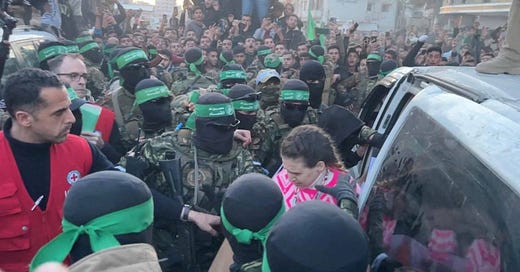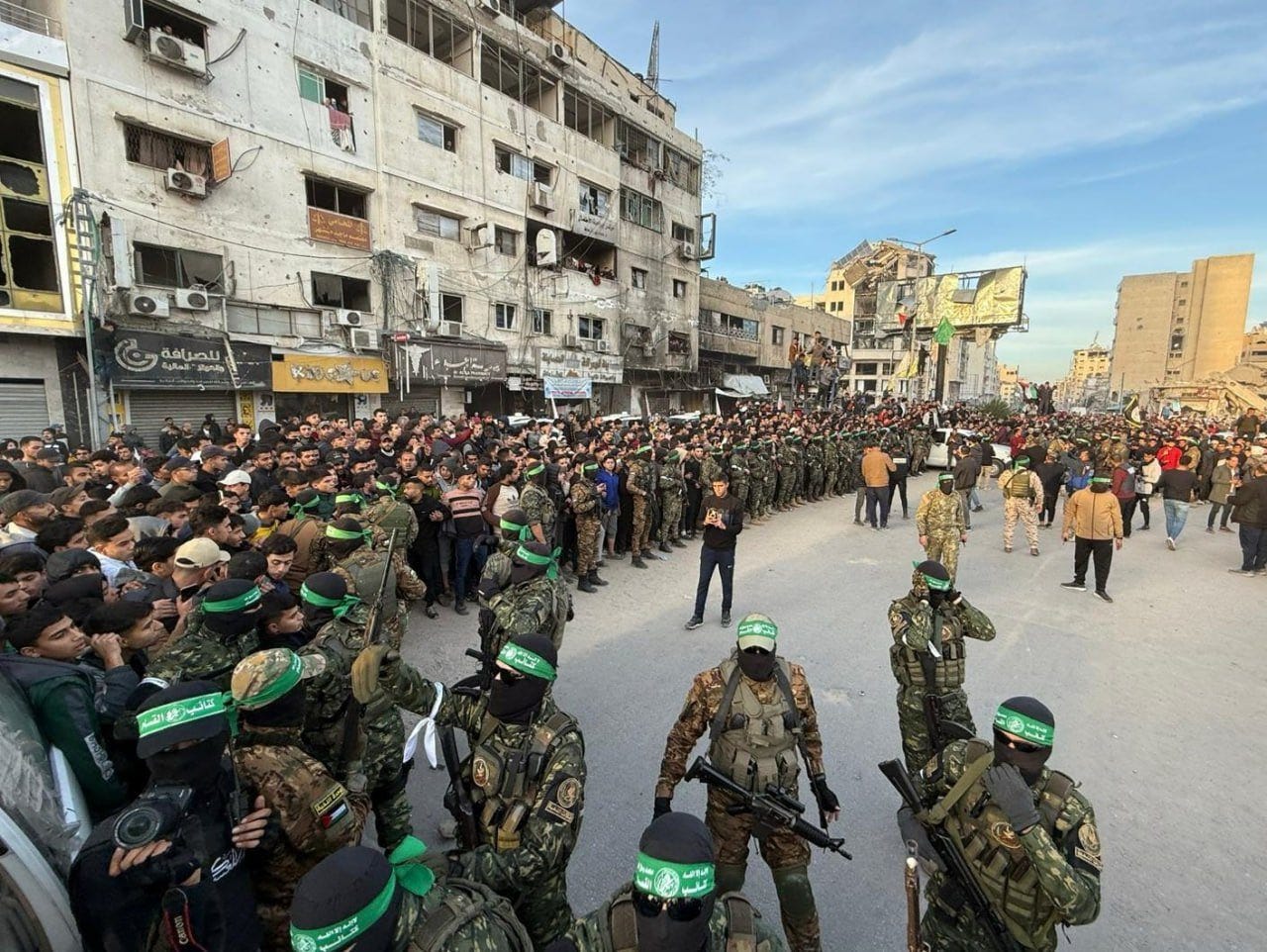Why did Israel release so many murderers?
The humanity of Jerusalem is not a weakness but a strength
Three innocent Israeli women. Ninety Palestinian terrorists. Such were the terms of the grim human transaction that took place last weekend. Granted, this was a very different deal from October 2011, when 1,027 prisoners – including Yahya Sinwar, the mastermind of the pogroms that darkened the globe 12 years later – were traded for a single Israeli soldier, Gilad Shalit. But many around the world looked on in bewilderment. Hamas has been on the ropes. Why did Israel, by far the stronger party, make such concessions?
Among the roughly 1,200 Palestinian prisoners due for release are monsters like Mohammad Abu Warda, who murdered 46 people in two bus bombings in the Nineties; Arafat Irfaiya, who rejoiced in raping and murdering Ori Ansbacher, 19, in 2019; and Mahmoud Atallah, who was sentenced to life in prison for the murder of a Palestinian woman accused of collaborating with Israel and went on to rape female prison guards. To see these depraved jihadis walk free, and to be welcomed by jubilant crowds, is enough to turn the stomach.
In truth, the number of terrorists released in the bargain was far from the biggest compromise agreed by Jerusalem. Hamas, which has been teetering on the brink of annihilation, is mainly concerned with ending to the fighting, so that it can survive, rebuild and fulfil its vow to repeat the October 7 atrocities again and again. Israel has vowed that this ceasefire will not mean an end to the war. But in ramping the campaign down so steeply when the fanatical enemy is only degraded by 80 per cent, it has cast this ambition into doubt.
The fineprint reveals no end of concessions. The fresh aid shipments are to be overseen by Hamas, enabling them to consolidate their control over the population. On day 20, the IDF will withdraw entirely from the strategically significant Netzarim corridor, which bisects the territory from east to west, allowing troops to battle in the north while preventing reinforcements from the south. No meaningful checks will be carried out on the people surging back to the north, allowing terrorists to freely re-establish themselves close to the Israeli communities on the other side of Gaza’s northern fence. There are also restrictions on aerial surveillance of the Strip, blinkering Israeli intelligence to Hamas movements. For Israel to recommence the war would require fresh evacuations of more than a million people.
Why did Benjamin Netanyahu do it? There are many answers to this question. Pressure from Donald Trump is top of the list. There was also fewer political hurdles in his way; the addition of Gideon Saar to the government in September meant that Netanyahu’s slender coalition no longer depended on far-right kingmakers. When their totem, the firebrand Itamar Ben Gvir, resigned in protest at the deal last week, Bibi was not brought down with him.
But the underlying reason for this lopsided deal is rooted in the Israeli social compact. The Jewish state is forced to place more demands on its citizens than any other democracy in the world and – as we have seen vividly in the past 15 months – its doughty people rise to the occasion. Deep in the DNA of many Israelis, for instance, is the drive to bring up a family in the borderlands, defying the risk of marauding Arabs in order to secure the boundaries of the state. Such an instinct is almost unimaginable to people in the cosseted West.
Josef Trumpeldor is a case in point. The one-armed Russian war hero and Zionist warrior laid down his life in 1920 in defence of the small outpost of Tel Hai, which lies on a finger of land sandwiched between Lebanon and Syria at Israel’s remotest perimeter. His last words became iconic. “Ein davar,” he said. “Tov lamut b’ad artzeinu.” (“It doesn’t matter. It is good to die for the sake of one’s homeland.”) After his death, “Tel Hai” became used as a salute by Betar, the youth movement that eventually gave birth to the Likud.
This hardy culture endures to this day among those living along Israel’s western, southern and northern borders. That is why the mass evacuation of more than 80,000 Israelis from the north under barrage from Hezbollah last year was such a trauma for the country. It felt like the opposite of the spirit of Tel Hai.
The impulse to live along a dangerous frontier is just one expression of Israeli patriotic sacrifice. The most dominant and widespread, of course, is national service, which is embraced by the majority of citizens. Since October 7, hundreds of thousands of people – conscripts and reservists, young and not-so-young – have had their lives turned upside down by the war. In addition to those who have laid down their lives, or were maimed in the fighting, are the countless reservists who have seen their businesses collapse or lost their jobs as a result of spending long periods of time in uniform.
This only works if the compact is reciprocal. The people of Israel send their sons – and often their daughters – into harm’s way on the understanding that if the worst were to happen, the state will move heaven and earth to get them back. This helps secure the bond between citizens and their neighbours and between the people and the government. It binds millions of individuals into a family.
Hamas’ failure to understand this was the precipitant of its demise. This may seem counter-intuitive; after all, although it has been defeated militarily, Hamas has won a decisive victory when it comes to the battle for hearts and minds. Its propaganda efforts, amplified by the international media and international organisations including the UN and the NGO-social media complex, have swept all before it, brainwashing millions of young people in democracies around the world and isolating the Jewish state. As evidence, look no further than the Gaza marches that continue in our capitals even now that a ceasefire has been achieved.
Doubtless, the fact that a jihadi group akin to Islamic State and Al Qaeda has managed to manipulate the free world into supporting it, against its most fundamental and existential interests, is a stunning disinformation success. Ironically, however, while this success was a product of a sophisticated theory of the Western mind in general, Hamas showed a more limited understanding of the Israeli national character.
I have mentioned here before the essay by neuropsychologist Orli Peter in which she drew a distinction between cognitive and emotional empathy. “Cognitive empathy is the ability to accurately understand and model the thoughts, feelings and values of others,” she writes. “It’s like hacking into someone else’s algorithm for how they think and feel, enabling you to predict their reactions to your actions.” Emotional empathy, on the other hand, is “the ability to feel what you believe the other person is experiencing”. Hamas has cognitive empathy in spadeloads, enabling it to develop a coldblooded knowledge of exactly what makes the Western mind tick. People in the democracies, however, have little such cognitive empathy about the enemy, blinding ourselves to the reality and preferring to assume that the jihadis of Hamas are deep down probably just like us. Not, in other words, an enemy at all.
When it comes to emotional empathy, however, a different dynamic comes into play. In the West, we have oodles of the stuff. That is how Hamas is able so easily to play with our passions. Show us an AI-generated suffering Palestinian baby and we’re anybody’s. Hamas has ruthlessly exploited this weakness by working hand-in-glove with international broadcasters to ensure that only footage of suffering civilians is broadcast to the West, never evidence of dead or wounded terrorists.
From a neuropsychological point of view, as Andrew Fox has argued, this activates the amygdala, which sits in the brain’s limbic system and is responsible for emotional reactions. In turn, this “shuts down critical thinking” by suppressing the logical prefrontal cortex with an emotional amygdala in overdrive.
“If you’ve been wondering why people who should know better are analysing this conflict hysterically,” he writes, “they’re either too deep in the amygdala stress process to analyse properly, or they’re trying to manipulate *you* into being in that state to effect *your* critical thinking processes and get an emotional reaction. Or both.”
Strangely enough, however when it comes to Israelis, the Hamas psychologists have a blind spot. Israelis are not like other Westerners. They may have exposure to the same social media and have the same life-centred culture (as opposed to the death cult of jihadism), but because of their unusually strong social bonds and the way their society has been forged in the flames of conflict since its inception, their emotional empathy is transmuted into a deep-seated resilience.
That is what drives the exchange of 1,200 Palestinian terror detainees for 98 Israeli hostages, living and dead. It is an expression of the passions, of emotional empathy. But unlike the emotional empathy of Britons or Americans, Israeli emotional empathy reinforces the bonds between citizens and reinforces national resilience.
That is why the gamble of October 7 did not pay off. Sinwar’s plan seemed flawless: provoke Israel by way of a massacre large enough to tip the region into war, then sacrifice Palestinian civilians on camera to manipulate the emotions of the international community. Once their outrage has shut down Israel’s response, wash and repeat. Or so the thinking went.
For all the cognitive empathy that allowed Hamas to build a model of the Western mind, their absence of emotional empathy proved their fatal flaw. If they had been able to feel what Israelis were experiencing, they would have understood that the fires of anguish they had stoked would only burnish the steel of resilience in the Israeli heart. Their failure to do so was what enabled the IDF to drive them relentlessly to the brink of the abyss, in defiance of international pressure. And with Donald Trump in the White House, it means that once the hostages are home, the troops will likely return to the field and complete the destruction, despite facing new obstacles.
Israel’s willingness to release so many prisoners for a single civilian is best understood as part of the glue that binds an unbreakable nation. Israel will long outlast the savages of Hamas, just as it outlasted the Nazis, the Romans, the Babylonians and the Greeks.
The humanity of Jerusalem is not a weakness. It is a strength.







I feel the tiniest bit better so thank you.
great read